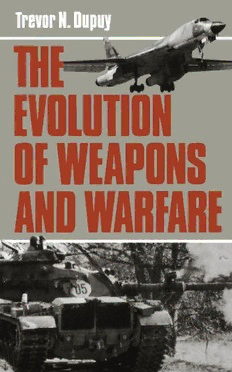
The Evolution of Weapons and Warfare PDF
Preview The Evolution of Weapons and Warfare
THE EVOLUTION OF WEAPONS AND WARFARE by Dupuy Colonel Trevor N. U.S. Army, Ret. The Bobbs-Merrill Company, Inc. Indianapolis/New York COUNTY PUBLIC LIBRARY ALLEN FORT WAYNE, INDIANA Copyright © 1980 by Trevor Nevitt Dupuy All rights reserved, including the right ofreproduction in whole or in part in any form Published by The Bobbs-Merrill Company. Inc. Indianapolis NewYork Library ofCongress Cataloging in PublicationData Dupuy, Trevor Nevitt. 1916- The evolution ofweapons and warfare. 1. War. 2. Arms and armor. I. Title. U21.2.D84 355\02 80-781 ISBN 0-672-52050-8 Designed by J. Tschantre Graphic Services Ltd. Manufactured in the United States ofAmerica First Printing To my princess 213Z3S2 Books by the author: To the Colors with R. Ernest Dupuy Faithful and True Military Heritage ofAmerica with R. Ernest Dupuy Campaigns ofthe French Revolution and ofNapoleon Brave Men and Great Captains with R. Ernest Dupuy Compact History ofthe Revolutionary War with R. Ernest Dupuy Civil WarLand Battles Civil WarNavalActions Military History ofWorld WarII (19 vols.) Compact History ofthe Revolutionary War with R. Ernest Dupuy Military History ofWorld WarI (12 vols.) The Battle ofAusterlitz Modern LibrariesforModern Colleges Ferment in College Libraries Military History ofthe Chinese Civil War The Encyclopedia ofMilitary Historyfrom 3500 B.C. to the Present with R. Ernest Dupuy Military Lives (12 vols.) Revolutionary WarLand Battles with Gay M. Hammerman Revolutionary WarNaval Battles with Grace P. Hayes Holidays Documentary History ofArms Control and Disarmament with Gay M. Hammerman Almanac ofWorld Military Power with John A. C. Andrews and Grace P. Hayes An Outline History oftheAmerican Revolution with R. Ernest Dupuy People & Events oftheAmerican Revolution with Gay M. Hammerman A Geniusfor War: The German Army and General Staff. 1807-1945 Elusive Victory: TheArab-Israeli Wars, 1947-1974 Numbers. Predictions and War Preface The origins of this book are many and are, to some extent, complex. Its principal source was a study that I directed, which was done for the U.S. Army by the Historical Evaluation and Research Organization (usually identified by its modest acronym, HERO) in 1964 and 1965, entitled: "Historical Trends Related to Weapon Lethality." But the book also reflects many other ideas about the relationship of military history to modern military affairs, which coalesced in my mind during the 1970s. I have become increasingly concerned by the lack of attention to historical experience in military analysis, and in the formulation of military policy, doctrine and plans in the United States, a con- cern that has been intensified by realization that our most likely opponent in a future war — the armed forces of the Soviet Union—have been, and continue to be, greatly influenced by their intensive study of modern military history. If this book in any way contributes to increased recognition on the part ofsenior Pentagon officials in and out ofuniform ofthe essentially evolutionary nature ofwarfare (no matter how revolutionary new weapons and technol- ogy may be), recognition that modern warfare always will be an ex- trapolation from past warfare, and realization that some aspects of war never change, then it will have accomplished its purpose. I am indebted to a number of people for their contribution to this book. First, I am grateful to Tom Gervasi for suggesting that I write it. I am grateful to the several colleagues who worked with me in 1964 and 1965 in the preparation of the study, "Historical Trends Related to Weapon Lethality." I am indebted to my current colleagues on the HERO staff who have contributed ideas, or who have stimulated my own thinking of these. I am particularly grate- ful to Paul Martell. Unquestionably my greatest debt of gratitude must be to my former and greatly respected colleague, Billie P. Davis, who (at my request, and with my guidance) took the confused mass ofthings I had written for the various chapters of this book, and pulled them vii — together into a coherent manuscript and in the process added some very relevant thoughts ofher own. While the concept, most of the ideas, and most of the words in this book are mine, and mine alone, their structure and presentation owe much to Billie. Had it not been for her devotion to the task, it is doubtful if the book would ever have been finished. Only slightly less important is the contribution of Grace P. Hayes, Vice President of HERO, and my colleague for longer than she or I care to remember. Her careful, thoughtful, repeated edito- rial reviews of the manuscript forced me to sharpen my ideas and tighten my wording from start to end. Ifthe book has merit, Grace is responsible to a very large degree. I received some very valuable suggestions from four respected historian colleagues to whom I sent the manuscript for comment. I am extremely grateful to Professor Martin Blumenson, Dr. Hugh M. Cole, Mr. Brereton Greenhous of the Canadian Directorate of His- tory, and Professor Theodore Ropp. Several members of HEROs administrative staff typed the var- ious drafts of the manuscript, including Blanche Griffin, Virginia Rufner, Laura Fentin, and Vicki Stumpf. The person most respon- sible for the production of the manuscript, however, was HERO's Administrative Director, Marie A. Tysinger. I am most grateful to her and her assistants for their help. I hope it is clear from these expressions ofgratitude that, ifthe book is good, many other people are in large part responsible. But if it has shortcomings, then I alone am responsible. T. N. Dupuy Dunn Loring, Virginia May, 1980
